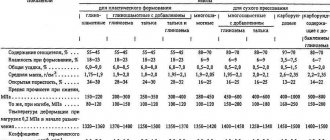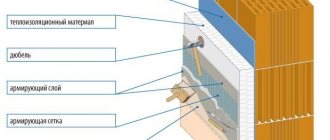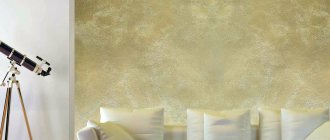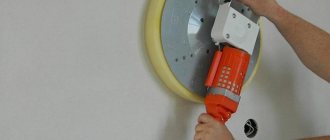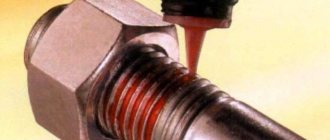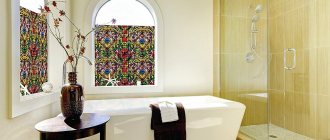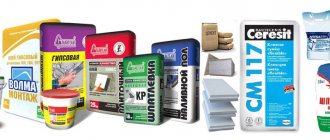Repairs are a common occurrence, because over time any building deteriorates or requires reconstruction. Or maybe you decide to build a new house or any other building. No renovation is complete without building materials, especially those necessary for exterior and interior decoration.
Plaster is the basis, with its help you can get rid of uneven walls . Unfortunately, builders often make mistakes during construction, and only finishing materials can correct them. Builders have several options to choose from:
For more information about cement-sand plaster, watch the video:
- gypsum based mixture.
Each of the proposed mixtures is unique in its own way and has its own properties that are suitable for certain jobs. In this article we will look at each type separately and determine for ourselves which is better.
Which plaster to choose?
The choice of finishing mixture depends on the scope of work. Which walls will you plaster, internal or external? The quality result always depends on the composition of the mixture. For interior decoration, a gypsum mixture is most often used, but for exterior decoration there is no better solution than cement. Find out the difference between plaster and putty.
But even among mixtures there are varieties and they differ in additives and fillers, some are needed for better thermal insulation, others are moisture-proof.
Additives are mandatory elements that help improve physical and chemical characteristics.
Operating efficiency is demonstrated by:
- in increasing productivity during finishing work;
- the quality of finishing increases;
- the service life of the structure is also significantly increased;
- repair costs fall;
- moisture resistance increases;
- durability of finishing;
- additives protect against fungal formations;
- increases adhesion to a variety of wall surfaces.
And this is only a small part of the advantages of various solutions that distinguish them from each other. The packaging always lists the properties of all the fillers inside.
So which plaster is better, gypsum or cement? The choice will depend on the type of work carried out during the repair period. Let's look at the properties of each and figure it out.
TOP 3 best leveling gypsum plaster for interior work
Volma Canvas
Due to its excellent technical parameters and good price-quality ratio, this domestic plaster is popular among finishers.
The gypsum base is supplemented with unique chemical and mineral additives, thanks to which the mixture has such qualities as rapid drying, the ability to retain moisture and excellent adhesion.
The mixture is suitable for leveling the surface of walls and ceilings with their further painting, under tiles or wallpaper.
The dry mixture is diluted with water at the rate of 650 ml per 1 kg and mixed well and evenly.
Homogeneity is maintained for about 20 minutes, the solution is very plastic and easy to work with.
True, some buyers point out that after drying and the plaster layer there is some color heterogeneity, this should be taken into account when choosing paint.
Main characteristics:
- The base of the mixture is gypsum.
- The surface texture is rough.
- Layer thickness, mm - 5-30.
- The mixture consumption according to the manufacturer is 9-10 kg per square meter. m. with a layer of 10 mm.
- Water consumption per 1 kg of mixture is 650 ml.
- The viability of the solution is 20 minutes.
pros
- Levels the surface well;
- plastic, easy to apply;
- retains moisture well and does not suffer from mold;
- durable, does not crumble.
Minuses
- uneven color after complete drying.
Prospectors Gypsum
A domestic version of gypsum plaster for leveling the inner surface of walls, which, due to the use of a special filler, has a reduced consumption - from 8 to 9 kg per square meter.
The mixture adheres well to mineral substrates (foam and aerated concrete), as it has good adhesion. True, the water resistance of the sample is low, so it is recommended to use it only in dry rooms with good ventilation.
This plaster is not recommended for beginners or amateurs, since the pot life of the solution is estimated at only twenty minutes.
Repeated dilution with water may result in reduced ductility and tenacity. The minimum layer should reach 5 mm, and the limit will be a thickness of 50 mm (but the layer can be compacted locally). An excellent option for a smooth finishing surface for painting or wallpaper.
Main characteristics:
- The base of the mixture is gypsum.
- The surface texture is smooth.
- Layer thickness, mm - 5-50.
- The mixture consumption according to the manufacturer is about 9 kg/m2 with a layer of 10 mm.
- Water consumption per 1 kg of mixture is 550 ml.
- The viability of the solution is 45 minutes.
pros
- can be applied locally up to 100 mm;
- lays flat and easy;
- plastic;
- Helps retain heat and reduce hearing.
Minuses
- no significant ones were found.
Rusean Plaster
Domestic gypsum plaster for manual application and distribution over the entire surface to be treated.
After drying, it has a uniform white tint, allowing you to start painting the walls without puttying, which is necessary for other samples.
Also, a smooth coating is formed at the finish, thanks to which you don’t have to worry about the quality of gluing thick wallpaper or get a textured coating with paints and varnishes.
The model has an adequate consumption of up to 9 kg per square meter, the solution stretches well and quickly levels out, without forming bubbles, and after drying without cracking.
For rooms with high humidity, it is better not to use this sample, even under tiles.
And it is better to entrust the application to a professional, since after 20 minutes it is almost impossible to work with the diluted mixture.
Main characteristics:
- The base of the mixture is gypsum.
- The surface texture is smooth.
- Layer thickness, mm - 5-50.
- Mixture consumption according to the manufacturer is 8 - 9 kg per square meter. m. with a thickness of 10 mm.
- Water consumption per 1 kg of mixture is 580 ml.
- The viability of the solution is 20 minutes.
pros
- applied evenly;
- smooth finish;
- no bubbles or cracks form;
- dries quickly.
Minuses
- only for residential premises with normal air humidity.
Gypsum plaster mixture
So, the dry mixture is powdery and white in color, and basically has:
- fine-grained gypsum;
- plasticizers;
- a number of polymer additives.
To obtain the finished mixture, builders simply need to add water. The ratio is also indicated on the packaging.
Due to gypsum, the mixture hardens much faster compared to cement. Thanks to its fine-grained structure, finishing with this plaster perfectly protects against drafts and moisture.
The time for hardening varies from several minutes to half an hour, much depends on the percentage of gypsum in the mixture. Such a foundation has a lot of advantages:
- environmentally friendly material;
- lasting;
- thermal stability;
- thermal conductivity.
The plastic structure allows you to remove or mask errors left by builders. Provides ease and uniformity of application of the solution to the walls. The polymers that make up the plaster interact better with the surface of the walls, which increases the strength of the future structure.
If the walls of the building have strong unevenness , or a thick layer is required, then it is better to use plaster with internal reinforcement.
It is worth evaluating the advantages and disadvantages of gypsum plaster.
The advantages include:
- perfectly levels walls and blemishes after finishing the main work.
- The composition is free of toxins and therefore safe.
- perfectly protects against moisture and harmful fungi.
- due to the lightness of the mixture, even in diluted form, the consumption of plaster and the load are reduced, especially on load-bearing walls.
- excellent sound insulation and thermal conductivity. The issue is especially relevant in multi-storey buildings.
- the material does not settle, therefore, once it hardens, it is not susceptible to cracking.
- universal material with excellent quality.
- the material provides high finishing speed. The plaster hardens after three days if the layer is not large. A thick layer of the mixture requires only a week.
- When finishing with gypsum, a reinforced mesh is not required for better adhesion to the surface, even if the layer is thick, due to the plasticity and viscosity of the material composition.
As for the negative traits:
- many may be put off by the price of the material, but it is compensated by the cost-effectiveness of consumption and the speed of working with the mixture;
- not suitable for metal surfaces;
- finishing in bathrooms is also not recommended, unless of course you use moisture-resistant plaster.
TOP 3 best thermal insulating gypsum plaster for interior work
Rusean Termoplast
White thermal insulating gypsum plaster, which can be applied to any substrate with different porosity levels.
It perfectly eliminates unevenness, after drying it has a uniform color and does not require additional putty. With a layer of 10 mm, from 8 to 9 kg per square meter is consumed, the permissible layer thickness starts from 5 and ends at 50 mm.
After preparation, the solution can be used for 20 to 30 minutes; repeated dilution with water is excluded, as this will reduce the durability and convenience of the material.
Thanks to their thermal insulating properties, they can replace special mineral wool and provide an optimal microclimate in the room, protecting it from drafts and temperature changes.
Main characteristics:
- The base of the mixture is gypsum.
- The surface texture is smooth.
- Layer thickness, mm - 5-50.
- Mixture consumption according to the manufacturer is 8 - 9 kg per square meter. m. with a thickness of 10 mm.
- Water consumption per 1 kg of mixture is 550 ml.
- The viability of the solution is 30 minutes.
pros
- affordable cost and low solution consumption;
- plasticity, dries evenly and does not crack;
- smooth surface without the need for putty.
Minuses
- no significant ones were found.
Unis Teplon Reinforced
Many finishing craftsmen prefer to work with this plaster, as it is plastic, stretches well and is easy to apply.
It has virtually no shrinkage, due to which the risk of cracks is reduced to a minimum. Thanks to the use of perlite, the manufacturer was able to reduce the specific gravity, so this solution can be used to safely treat the surface of the ceiling; the layer will not overload the base.
Perlite also affects additional thermal insulation properties, so this sample is often used in rooms where it is not possible to use specialized mineral wool to insulate the room.
It is allowed to lay this plaster in rooms with high humidity, but only if tiles are planned to be laid on top.
Main characteristics:
- The base of the mixture is gypsum.
- The surface texture is smooth.
- Layer thickness, mm - 5-50.
- The mixture consumption according to the manufacturer is 4.5 - 5 kg per square meter. m. with a layer thickness of 5 mm.
- Water consumption per 1 kg of mixture is 500 ml.
- The viability of the solution is 120 minutes.
pros
- with perlite, moisture-retaining;
- good white shade;
- cheaper than many analogues;
- the solution does not harden for a long time, it is convenient to work without dilution.
Minuses
- no significant ones were found.
Perfecta Gipstar
Popular and high-quality gypsum plaster for leveling walls and ceilings in residential areas with normal humidity.
Sold in 30 kg paper bags, the finish gives a white and smooth surface.
After mixing, the solution can be used for two hours, so this sample is loved by both professionals and beginners in finishing work.
You can stick wallpaper on top of the plaster, apply several layers of paint, or lay tiles. The mixture is applied manually; it is not suitable for the machine method.
It has decent thermal insulation properties, high ductility and adhesion, and some users also indicate good sound insulation abilities.
The permissible layer thickness is from 5 to 60 mm; with a layer of 10 mm, up to 9 kg of mixture will be needed per square meter.
Main characteristics:
- The base of the mixture is gypsum.
- The surface texture is smooth.
- Layer thickness, mm - 5-60.
- Mixture consumption according to the manufacturer is 9 kg per square meter. m. with a layer of 10 mm.
- Water consumption per 1 kg of mixture is 550 ml.
- The viability of the solution is 120 minutes.
pros
- white, smooth surface;
- good solution consumption;
- the solution is suitable for use for up to 2 hours.
Minuses
- not suitable for rooms with high humidity.
Application
Gypsum plaster is most often applied to brick and concrete walls or floors. It is more often used for interior decoration. Paint can be applied perfectly over this type of plaster.
You can also hang wallpaper, but before final finishing you need to dry the room thoroughly so that the plaster does not swell and fall off later.
Since gypsum hardens quickly, the solution is diluted in small proportions, as prescribed in the instructions. It is better to calculate the required amount in advance, because if you re-dilute it, the properties of the mixture will be lost.
Walls for which gypsum plaster is intended to be used may have a different surface. For very curved walls, it is necessary to apply a liquid layer of plaster as the first layer, and after it dries, a thicker layer is applied.
Finishing with cement base
Cement has always been the most durable material, so it is often used not only in construction, but also in finishing the building. The cement base will provide your home with:
- durability;
- strength;
- crack resistance;
- moisture resistance;
- plastic.
Cement plaster is often used in rooms with high humidity or, conversely, in poorly heated rooms. The cement will provide strength due to its granular base. If you use a mesh when decorating walls, you can lay a thick layer of 5 cm. How many buckets fit in a bag of cement weighing 50 kg. This link will tell you.
Excellent for exterior decoration, due to its resistance to temperature changes and weather changes.
pros:
- the price is significantly lower than for gypsum;
- a similar mixture can be prepared at home using available materials;
- temperature resistance, as well as to moisture;
- the mixture hardens for a long time, so you can work with it for a long time;
- environmental friendliness.
Flaws:
- does not adhere well to concrete;
- difficult to work with, too heavy material;
- not suitable for wood flooring.
Cement plaster has been used for many centuries, so many builders trust this finishing material.
TOP 3 best gypsum plaster for interior work for machine application
Volma Gips-Active
The solution, which, when properly mixed, remains suitable for an hour and a half, can be applied to walls and ceilings either manually or by machine.
The permissible layer thickness is from 5 to 30 mm, but in some areas it is possible to increase the thickness to 50-60 mm.
This plaster is always applied over a primer, which will protect the mortar from cracks, ensure a perfectly smooth smoothing and provide a high degree of durability.
The plaster has good plasticity indicators, so even a beginner can work with this sample, especially since the consistency after mixing retains its main properties for up to 1.5 hours.
Suitable only for rooms with normal humidity; in the bathroom or kitchen it is not able to last long.
Main characteristics:
- The base of the mixture is gypsum.
- The surface texture is smooth.
- Layer thickness, mm - 5-30.
- Mixture consumption according to the manufacturer is 8 - 9 kg per square meter. m. with a layer of 10 mm.
- Water consumption per 1 kg of mixture is 650 ml.
- The viability of the solution is 90 minutes.
pros
- good adhesion to the wall;
- plastic;
- suitable for decorative plaster;
- optimal time to work with the solution.
Minuses
- no significant ones were found.
KNAUF MP-75
A dry mixture based on fine-grained gypsum, which was intended for machine application to interior walls.
If we compare this sample with plaster from the Rotband company, then there is an undeniable advantage - the use of defoamers, plastifiers, thanks to which the solution stretches better, and hardening retarders.
Therefore, this product is considered an excellent option not only for a professional master, but also for a beginner.
The solution can also be applied manually; after mixing, it does not thicken for two hours. Smooths out quickly and easily, fills unevenness and cracks well.
At the same time, it remains even and smooth, without bubbles or other surface damage.
The mixture is suitable for horizontal and vertical substrates, and with additional protection it can be used in the bathroom or kitchen, that is, where humidity is usually high.
Main characteristics:
- The base of the mixture is gypsum.
- The surface texture is smooth.
- Layer thickness, mm - 8-50.
- Mixture consumption according to the manufacturer is 8 - 9 kg per square meter. m. with a layer of 10 mm.
- Water consumption per 1 kg of mixture is 650 ml.
- The viability of the solution is 120 minutes.
pros
- the solution does not thicken up to 2 hours;
- stickiness, plasticity;
- the surface becomes glossy and smooth;
- Suitable for machine application.
Minuses
- difficult to find in regular chain stores;
- takes a long time to dry (up to a week until completely dry).
Prospectors Optimum
Gypsum plaster from a domestic brand, produced in 30 kg paper bags and intended for treating interior walls and ceilings in dry rooms with normal humidity levels.
The thickness of the layer can vary from 6 to 60 mm, the mixture has good plasticity and excellent stretch, allowing it to be quickly and evenly distributed over the surface. After preparation, the solution is suitable for use for 90 minutes.
The plaster can be applied either manually or by machine, which indicates its versatility and good technical characteristics.
After drying, the shade is uniform, without bubbles or cracks, the coating does not peel off and is in good contact with paint, wallpaper and tiles.
Main characteristics:
- The base of the mixture is gypsum.
- The surface texture is smooth.
- Layer thickness, mm - 6-60.
- The mixture consumption according to the manufacturer is 10 - 11 kg per square meter. m.
- Water consumption per 1 kg of mixture is 400 ml.
- The viability of the solution is 90 minutes.
pros
- Rubbing to gloss is allowed;
- duration of use of the finished solution;
- does not crack, durable;
- low water consumption.
Minuses
- high mixture consumption;
- takes a long time to dry.
Cement-sand wall decoration
This is a fairly economical option used in construction. In addition, cement-sand plaster is used for any type of finishing, and what is most important, it can be used even in mild frosts down to -10 degrees.
It is excellent to use DSP when screeding floors, durability is guaranteed. And curved brickwork is perfectly leveled for subsequent decorative finishing with paint, wallpaper or other suitable materials.
One of the disadvantages of this plaster is that it gives sediment, so it is worth calculating the errors in advance. This material will tell you about the cement-sand mixture.
How to work with plaster correctly?
From the mixtures described above, you can now judge for yourself which material is suitable for your work. A cement base is ideal for rough finishing; it will help smooth out all the flaws made when laying the walls.
In this regard, cement is a practical choice, because its use is possible under the most extreme and technically difficult conditions. High resistance to weather changes makes the cement mixture ideal for finishing building facades with warm plaster.
Of course, if you use structural plaster for interior work, the ideal material would be a gypsum base, which will provide preparation for the final finishing with decorative materials.
When choosing future plaster for wall finishing, you need to clearly define the main points of the work :
- required layer;
- room humidity;
- wall structure.
The mixtures can be used for manual and machine work. Carefully study the instructions and documentation of the manufacturer of building materials. The finishing surface must be cleaned from imperfections and dirt;
If you need to apply several layers, it is better to apply them gradually to avoid defects. So which mixture is better, gypsum or cement? Each of them is suitable for certain jobs and is good in its own way. When making a choice, you should first decide where and which one is best.
Good luck with your renovation or construction, be careful about the selection and consumption of materials, this will save you both money and time.
The modern market for finishing materials includes dozens of different types of products, among which there is a huge range of plasters. Each item of this product has certain characteristics, and although many plaster mixtures are offered as universal ones, in absolute terms multifunctional solutions suitable for all occasions do not yet exist. Therefore, when starting a renovation or starting the finishing work stage of building a house, the owners ask themselves: which plaster is better, Rotband or Volma. And yet, the concept of “best plaster” should be considered in the prism of specific purposes and conditions of use.
This even applies to materials that are related in scope, technical and operational properties, such as the above-mentioned compositions made on the basis of binder gypsum - Rotband or Volma-Sloy. Therefore, in order to make a choice, let’s take a closer look at each type of this plaster product in more detail.
TOP 3 best gypsum plaster for interior work, small packaging 5-10 kg
KNAUF Rotband, 10 kg
Universal plaster for interior finishing work, which is created on a gypsum basis and with additives that provide increased adhesion.
Thanks to this, the base does not necessarily need to be primed; the solution will lie tightly and be easily distributed over the surface. A layer thickness of 5 to 50 mm is allowed; with a layer of 10 mm per square meter it takes up to 8.5 kg.
The solution is diluted according to the recipe, 600 ml of water is used per kg of the mixture, after which the plaster must be completely used within 25 minutes, since it cannot be diluted with water again.
Even with a thick layer, the plaster does not crack and gives a smooth surface at the finish, which is ideal for painting or wallpapering.
Due to its high water-holding capacity, it is suitable for installation in the bathroom or kitchen, allows you to regulate the microclimate in the room, and allows air to pass through well.
Main characteristics:
- The base of the mixture is gypsum.
- The surface texture is smooth.
- Layer thickness, mm - 5-50.
- Mixture consumption according to the manufacturer is 8.5 kg per square meter. m. with a layer of 10 mm.
- Water consumption per 1 kg of mixture is 600 ml.
- The viability of the solution is 25 minutes.
pros
- affordability;
- uniform gray tint;
- easy leveling;
- does not crumble or crack.
Minuses
- fakes are common;
- only for dry rooms.
Unis Teplon, 5 kg
This gypsum plaster for interior decoration is considered one of the best representatives of its kind, as it has a pure snow-white color.
Designed for finishing walls and ceilings in rooms with normal humidity, best for painting or wallpaper. Without using a plaster mesh, the mixture can be applied in a layer up to 5 cm thick.
It is also possible to use this mixture in the bathroom or kitchen if tiles will be laid on top.
The plaster received high marks from experts due to its unique formulation, which ensures quick drying, as well as plasticity, moisture resistance and reduced costs for giving the walls a white tint.
The surface is smooth, but porous substrates must be primed, since adhesion indicators are insufficient, they can affect the further consolidation of the mixture.
Main characteristics:
- The base of the mixture is gypsum.
- The surface texture is smooth.
- Layer thickness, mm - 5-50 kg.
- Mixture consumption according to the manufacturer is 4 - 4.5 kg per square meter. m. with a layer of 5 mm.
- Water consumption per 1 kg of mixture is 500 ml.
- The viability of the solution is 50 minutes.
pros
- can be used under tiles in damp areas;
- suitable for machine application;
- the solution does not thicken for a long time, allowing you to work slowly;
- good ductility and tenacity.
Minuses
- Primer of a porous base is required.
Bergauf Bau Putz Gips, 5 kg
Gypsum plaster with high crack resistance . Easy to work, flexible,
stretches well and is evenly distributed over the surface, without the appearance of bubbles or pits.
Not suitable for application in a thick layer, the maximum allowed is 30 mm. The line includes three colors for the buyer to choose from: grey, white and beige.
Can be applied over concrete, brick, plaster, aerated concrete, suitable for sealing joints. Dries quickly and colors evenly.
To dilute the solution, you do not need a lot of water; 420 ml of water is used per kg of mixture. The solution is suitable for use for about an hour, then it should be replaced (repeated dilution has a negative effect on density and durability).
Main characteristics:
- The base of the mixture is gypsum.
- The surface texture is smooth.
- Layer thickness, mm - 5-30.
- Mixture consumption according to the manufacturer is 11 - 13 kg per square meter. m. with a layer of 10 mm.
- Water consumption per 1 kg of mixture is 420 ml.
- The viability of the solution is 60 minutes.
pros
- three colors: gray, beige and white;
- fine grain, good leveling and durability;
- no cracks form;
- smooth finish.
Minuses
- takes a long time to dry.
High-tech gypsum plasters: comparison of mixtures
Gypsum dry plasters are environmentally friendly finishing materials, which is an important factor in interior decoration. Volma and Rotband are made from several components: gypsum, filler and polymer additives.
Rotband is produced by Russian factories using German technology from the Knauf company and differs in viscosity, size class and shade. The prepared solution is used to level the base surface of wall and ceiling structures made of concrete, brickwork, cement-concrete slabs, and expanded polystyrene. Among the positive aspects of the mixture, experts note:
- good adhesion indicator;
- plastic;
- no shrinkage after drying of the plastered surface, high degree of resistance to cracking.
Due to the resulting smooth and even plastering surface, the walls do not require subsequent mandatory puttying and allow the finishing to be applied by gluing wallpaper, painting or tiling. Rotband is different in that the solution is applied only by hand and is used exclusively for interior work. The plasticity of the mass allows even craftsmen without sufficient experience to work with it.
Volma gypsum plaster compositions include several modifications, the Volma-Sloy version is used for manual work, and the Volma-Sloy-MN mixture is intended for machine plastering. The solution is used for leveling, and since the mixture is finely ground, the surface of the coating is smoothed to the state of soft putty, and the walls acquire impeccable evenness. They are coated with paints or decorated with wallpaper. The material is valued for the following qualities:
- non-shrink drying;
- compatibility and excellent adhesion to any surfaces;
- resistance to cracking and delamination.
Repair and restoration work: which is better Rotband or Volma
Both types of plaster are used when engaged in restoration work and the manufacture of various types of decorative elements for premises. Due to the soft, homogeneous and elastic mixture of gypsum plasters, they have become widely used in interior decoration.
The material is used to create relief panels, ceiling moldings and other decorative elements. Such products dry quickly and adhere perfectly to flat surfaces of the ceiling and walls. In this area of application, Rotband or Volma are identical materials, and the choice in favor of one of them is exclusively individual and subjective.
The only thing that numerous reviews from professional and home craftsmen warn about is that Volma plaster, produced at the Chelyabinsk plant’s facilities, is not always of high quality, and they manage to counterfeit the more expensive Rotband.
What is the difference between Rotband and Volma?
As evidenced by the characteristics of both gypsum plasters, the materials have almost identical qualities and service life, and equally meet installation, environmental and operational requirements. However, Rotband, having appeared on the Russian market back in the 90s, had great advertising support, and therefore is well known to a wide range of consumers.
A significant difference in the cost of materials with almost the same consumption often plays a primary role in the choice of dry plaster. Rotband is more expensive, so by buying Volma, the consumer can save a significant amount of money.
This is probably where the materials differ. Otherwise, if the work is performed with a high-quality original plaster mixture, the technology and manufacturer’s recommendations are followed, the result will be the same. Therefore, the decision on the issue of Rotband or Volma-Layer: which is better to purchase, rests at the discretion of the master.
*Review of the best according to the editors of expertology.ru. About the selection criteria. This material is subjective in nature, does not constitute advertising and does not serve as a purchase guide. Before purchasing, consultation with a specialist is required.
Plaster mixtures are widely used in the construction industry. If earlier this material was used exclusively for leveling walls and ceilings, today some compositions are used for decorative finishing. Accordingly, the range of plasters has expanded. Today it is already difficult to find builders who prepare their own cement-lime mortars. They have been replaced by innovative developments that simplify not only the preparation of the solution, but also the application and leveling. Once in a construction supermarket, an ordinary person can easily get confused. In order not to make a mistake in choosing plaster, it is worth getting acquainted with the recommendations of specialists.
TOP 3 best gypsum plaster for interior work by price/quality for 2021
KNAUF Rotband
If you ask any finishing specialist to name a few of the best plasters, you will definitely hear this sample on the list.
A high-quality gypsum-based mixture is used to level internal walls and ceilings both in living rooms and in the bathroom or kitchen. The main feature of this plaster is the ability to apply a layer on top of any base, including concrete or brick.
Special polymer fillers increased adhesion and made the application process easier.
The sample has many certificates of conformity; experts consider this plaster to be one of the best in terms of fire resistance (and, therefore, fire safety), environmental friendliness and vapor permeability.
Yes, the price is slightly higher than that of competitors, but the quality is beyond doubt and guarantees ease and safety of finishing.
Main characteristics:
- The base of the mixture is gypsum.
- The surface texture is smooth.
- Layer thickness, mm - 5-50.
- Mixture consumption according to the manufacturer is 8.5 per sq.m. (layer 10 mm).
- Water consumption per 1 kg of mixture is 0.6 liters.
- The viability of the solution is 25 minutes.
pros
- dries quickly;
- It is used quite economically;
- plasticity, stickiness;
- Suitable for leveling strong defects.
Minuses
- due to quick drying, it is more suitable for specialists;
- very popular, fakes are often produced.
Volma Layer
Domestic dry mixture on a gypsum basis, which contains lightweight aggregate, modifying additives and mineral fillers, thanks to which it was possible to achieve optimal operating time, high adhesion and good water-holding capacity.
It is recommended to use for leveling walls and ceilings in rooms with normal humidity; the permissible layer thickness is determined by a framework of 5 to 30 mm, but in some places it can reach 60 mm.
When properly mixed and applied, the plaster after drying gives a glossy surface, on top of which no additional putty is required.
The mixture is for manual application only. The solution does not change its texture within 20 minutes. It can be applied without priming, but in this case the base must be wetted with water.
Main characteristics:
- The base of the mixture is gypsum.
- The surface texture is smooth.
- Layer thickness, mm - 5-30.
- Mixture consumption according to the manufacturer is 8-9 kg per sq.m. (layer 10 m).
- Water consumption per 1 kg of mixture is 650 ml.
- The viability of the solution is 20 minutes.
pros
- fits well even at low flow rates;
- suitable for quick repairs, does not require additional putty;
- dense, plastic texture;
- holds up well and doesn't fall off.
Minuses
- batches have different quality;
- not suitable for machine application.
Weber Vetonit Profi Gypses
Plastic plaster on a gypsum basis, which includes microfiber, which provides good viscosity and consistency.
The solution dries quickly and evenly, without cracking or shedding. Finely ground gypsum is easier to apply and level; with a layer of 10 mm, from 8.5 to 10 kg per square meter is consumed.
Due to increased adhesion, peeling does not occur even in those places where a thick layer is used.
Apply to any surface, including concrete, brick, gypsum sheets. This is a domestically produced plaster, packaged in 30 kg paper bags. It masks defects well and is suitable for painting, wallpaper or under tiles, but only in rooms with normal air humidity.
It takes up to 5 days for complete hardening; the period can and will decrease with uniform ventilation of the work room.
Main characteristics:
- The base of the mixture is gypsum.
- The surface texture is smooth.
- Layer thickness, mm - 5-50.
- The mixture consumption according to the manufacturer is 8.5 - 10 kg per square meter with a layer of 10 mm.
- Water consumption per 1 kg of mixture is 550 ml.
- The viability of the solution is 40 minutes.
pros
- easy to mix;
- dries quickly;
- strong, holds well, does not crumble;
- easy to apply in an even layer.
Minuses
- no significant ones were found.
